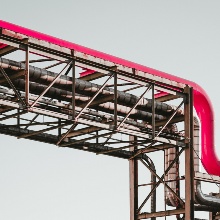How can district heating networks contribute to achieving the 2045 climate target? This is the question addressed by a study conducted by researchers at the Institute of Energy Economics and Rational Energy Use (IER) at the University of Stuttgart, as part of the Ariadne Copernicus project. Their conclusion: District heating could make a contribution to achieving climate neutrality targets. However, transforming energy networks requires high levels of investment, for which incentives must be created.
Currently, the topic of heat pumps is dominating public discussion, and in the process, another important aspect of decarbonization of the housing sector is being pushed into the background: The district heating supply and its networks. Particularly in densely populated areas, with apartment buildings and poorly renovated old buildings or even listed buildings, the district heating supply provides an important alternative to heat pumps. However, the district heating supply must also become climate-neutral, and the existing networks must be adapted to achieve this. In a new Ariadne analysis, researchers from the Institute of Energy Economics and Rational Use of Energy at the University of Stuttgart have investigated the costs of converting district heating networks and the planning, technical and financial challenges involved.
In order to be able to transport district heating created using renewable energies into households, existing heating networks often have to be adjusted to low flow temperatures, from currently mostly over 100 degrees to 90 degrees and later to 60 degrees. The Ariadne researchers have calculated that this conversion will cost a total of around 13 billion euros and that the utilities will only be able to finance 10 percent of these investments (over the 20-year period under consideration) through government subsidy programs and levies on end customers. Given this funding gap and the investment challenge of converting district heating to carbon-neutral generation, utilities lack the incentive to implement the energy transition in heating quickly. Ultimately, however, the costs, especially the capital expenditures, would be many times more expensive if other climate-neutral technologies were used.
On average, an energy supplier in a major city would have to invest 135 million euros in converting existing networks to low temperature. "To mitigate the looming funding gap, we propose that network densification and digitalization could be used to reduce investment costs and that consistent, accelerated, and large-scale municipal heating planning could be used to make the conversion of district heating networks more efficient in the long term," say authors Prof. Markus Blesl, Alexander Burkhardt, and Frank Wendel at the IER "In this way, the conversion of existing district heating networks could make an optimal contribution to achieving climate targets in economic terms."
Publication (in german):
Markus Blesl, Alexander Burkhardt, Frank Wendel (2023): Transformation und Rolle der Wärmenetze. Kopernikus-Projekt Ariadne, Potsdam. DOI: 10.48485/pik.2023.004
| Contact | Alexander Burkhardt, University of Stuttgart, Institute of [LR1] Energy Economics and Rational Energy Use (IER), Tel. +49 711 685-87500, Mail alexander.burkhardt@ier.uni-stuttgart.de |
|---|


